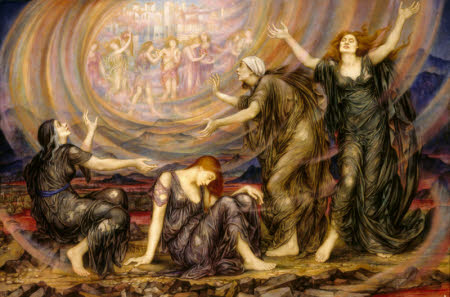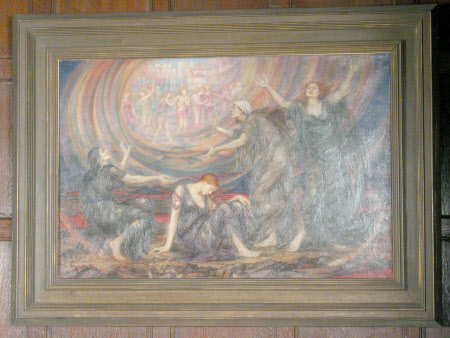The Mourners
Evelyn De Morgan (London 1855 - London 1919)
Category
Art / Oil paintings
Date
1910 - 1916
Materials
Oil on canvas
Measurements
603 x 895 mm (23 3/4 x 35 1/4 in)
Place of origin
London
Order this imageCollection
Wightwick Manor, West Midlands
NT 1288978
Caption
In 1873, at the young age of 17 and despite her parents’ opposition, Mary Evelyn Pickering (later De Morgan) was one of the first women to enrol at the recently established Slade School of Art in London. This was one of the few schools at which women could access life models (at least, before 5pm) – both female nudes and partially draped males – which had long been a foundational part of a state education in art for men but was radically new for women. Pickering flourished at the Slade, winning prizes for her life drawing, receiving the prestigious Slade Scholarship and spending time in Italy studying the work of Renaissance masters. Adopting her gender-ambiguous middle name so that her work would be judged on its merit alone, from 1876 Evelyn began to exhibit and sell her paintings to critical acclaim. In 1886 she married potter William De Morgan, supporting his art pottery business through the sales of her work. Evelyn De Morgan was part of the later Pre-Raphaelite circle, which included many women artists. She is considered a pioneer of the allegorical female nude and her paintings often centre on the female body. Her early works are history paintings – drawing on biblical, literary or mythological sources, these were considered the most prestigious subjects for an artist and reflect her professional ambition. Her 1885 pastel study for a later oil painting, Clytie with Sunflowers, is a fine example (NT 1288980). Clytie stands nude, rooted in a patch of sunflowers, grieving the loss of the love of Helios, the god of the sun. Her arms are raised in a protective pose, as she turns away from Helios’s rays. De Morgan’s later works explored ideas around spirituality and were also profoundly impacted by the events of the First World War. The Mourners is one a group of symbolic, pacifist paintings that directly respond to the conflict, which De Morgan exhibited at her studio in 1916 to raise funds for the Red Cross and the Italian Croce Rossa.
Summary
Oil painting on canvas, The Mourners by Evelyn de Morgan (London 1850 or 1855 - London 1919), signed, lower left: EDeM. Four, circa 1915. Lamenting figures in robes with arms raised in despair, departed figures in background with circular swirling water/air.
Full description
This is one of the series of symbolic pictures of war subjects inspired by Evelyn De Morgan's distress over the First World Way. She showed this and thirteen others in her studio in 1916 to raise funds for the Red Cross. An original label on the reverse reads: '"The Mourners" (One of a series of six war pictures painted by Evelyn De Morgan) The unhappy people, in their misery, are haunted by a vision of past happiness'. The picture reflects her preference for allegorical or symbolic figure subjects. The figures of women in rags in a barren landscape, all in sombre tones, suggest desolation and grief. They see a vision, bathed in golden light, of an idealised but obviously Italian city and figures playing music, laden with flowers, carrying a cornucopia etc., symbolising joy and plenty. The picture has all the characteristics of De Morgan's work.The intensely linear quality and elaborately patterned drapery reflect the influence of Burne-Jones, and the imaginary bare and rocky landscape setting has similarities with his works such as 'The Passing of Venus' and 'Perseus Pursued by the Gorgons'. But the hard-edged draughtsmanship and dramatic use of colour are quite different, owing much more to her love of 15th-century Italian art. The strong composition, producing a vortex effect, is particularly striking.
Provenance
Owned by Emilie Russell-Barrington (Walter Bagehot's) sister-in-law, who lived in Longport, Somerset until her death in 1933. She was a friend of the De Morgans and wrote Bagehots, Leighton's and William De Morgan's biographies and was a friend of Mrs Nassau Senior. Russell-Barrington owned it by 1919, as she lent it to a Leighton House exhibition with other works.Next known provenance is that it was owned by Mrs Elizabeth Mitchell, Bartholomew House, Woodstock, who gave it to her daughter, Janet Mary Mitchell, who initially lent it to the National Trust (at Lanhydrock, Cornwall) in January 1973, but decided by August that she would give it; transferred to Wightwick Manor in 1998.
Marks and inscriptions
E de M (signed)
Makers and roles
Evelyn De Morgan (London 1855 - London 1919), artist
Exhibition history
Our Lady of Peace: The Pacifist Art of Evelyn De Morgan (1900-1919), Blackwell Arts & Crafts House, Cumbria, 2015
References
Gordon 1996 Catherine Gordon (ed.) Evelyn De Morgan Oil Paintings, De Morgan Foundation 1996, no. 95 Conroy, Rachel, Women Artists and Designers at the National Trust, 2025, pp. 144-147

